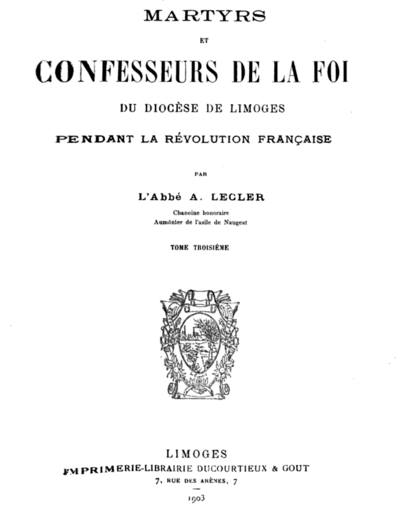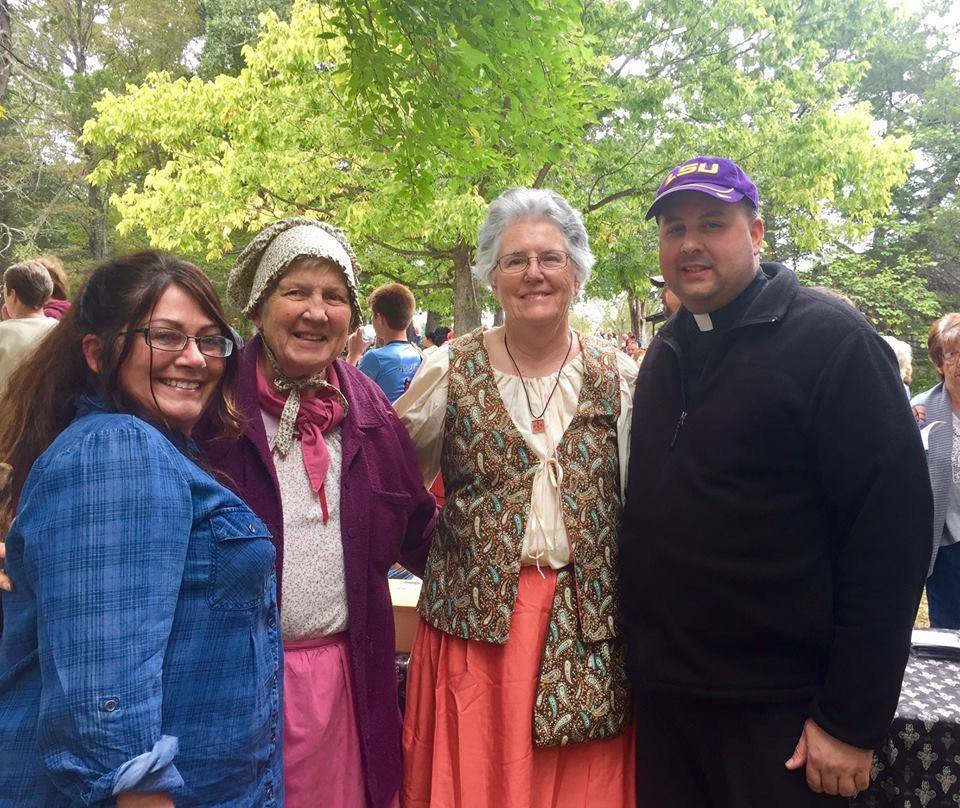Feast of All Saints!
Happy feast of All Saints! There are at least two connections to the Védrines-Vidrine family that we can remember on All Saints Day.
One was Fr. Jean Védrine (1743-1807). He is considered a Confessor of the Faith of the Diocese of Limoges (one who suffered for the faith, although they didn’t die for it like the martyrs) during the French Revolution. It’s an incredible story! It is unlikely that he belonged to our branch of the Védrines Family in France, but Limoges (and the Department of Creuse) is one of the possible places that the Védrines family originated before our branch moved to Ste. Livrade.
The other, of course, is the incredible life of the great grandmother of the matriarch of the Vidrine Family in LA (Elisabeth de Moncharvaux) – Marie Rouensa (1677-1725).
————————————————–
Fr. Jean Védrine was born on March 8, 1743 at Lepinas, parish of Salesse, currently  annexed to that of Saint-Agnant near Crocq.
annexed to that of Saint-Agnant near Crocq.
He had two nephews, Jean and Mathieu Védrine, Priests like him, who were deported during the persecution of the Revolution.
He was assigned as Curate (Pastor) first at Magnat-l’Etrange, and then in Champagnac, where Fr. de Saint-Juilen, Curate of that Parish “relied completely on him for everything concerning the spiritual administration, and even entrusted to him the management of the parish’s property and his personal possessions.”
Fr. Védrine, a Priest of very austere virtue, man of study and of great knowledge, was an especially remarkable theologian and very sought-out preacher; “which is not disputed at Haute-Marche, where he preaches at most of the parishes.”
The Bishop of Limoges, on May 26, 1787, appointed him as Curate of Saint-Agnant near Crocq, which had been left vacant by the death of Fr. Pierre Rougier. He was serving this parish when the the famous civil Constitution of the Clergy was enacted. Presented with all of the arguments for it, it became a most treacherous trap; a number of Priests left to take the oath to it. After a few regrettable defections, of which one might be able to invoke good faith as a mitigating circumstance, it addressed especially the most remarkable Priests known for their learning and piety, in order to surely lead others by their example. Fr. Védrine became the focal point of everything; he was wanted at all costs to win him over for the cause of schism; the most important people of the country multiplied their dealings with him; but all was useless. He still refused and did so with indignation; He even succeeded to maintain the extra duties of his less enlightened colleagues, who felt shaken and hesitant.
“Forced to go into hiding to avoid death, Fr. Védrine never resigned from the field of battle or abandoned his dear sheep who needed their Shepherd more than ever. He spent several years of his wandering life in Haute-Marche. He administered the Sacraments and offered the Holy Sacrifice of the Mass during the night, in barns, in the woods, and in safe houses, exposed at any moment to fall into the hands of the minions of the Revolution. But Providence watched over him.”
It is reported in particular that one day while saying Mass in Lepinas in the house of his parents, the police arrived while he was still at the altar. He barely had time to retreat to the hiding place which served as his refuge, while the sacred vessels and vestments were put at the bottom of an armoire. The people who were present assisted in silence and dismay, certain that the gendarmes’ search would bring a discovery. But the police didn’t find anything, and Fr. Védrine was saved again. A unique fact: one of the policemen later became a parishioner of Mr. Annet Védrine, Curate at Arnac-la Poste, who was the nephew of our confessor of the faith. He certifies the accuracy of this fact, whose family has always safeguarded the memory.
It is not known if Fr. Jean Védrine left France. However, his name was on the list of deported Priests of the department of Creuse.
After the Revolution, the former Curate of Saint-Agant, at his request, was again appointed to his former parish. Shortly after, he was the Priest-Dean of La Courtine. This is where he died in March of 1807 at the age of sixty-four.
Martyrs et confesseurs de la foi du Diocèse de Limoges, pendant La Revolution Francaise, Volume 3, p. 540-542
————————————————–
Marie Rouensa has never been officially canonized as a Saint, but her life was very saintly, leaving a great influence on the spirituality and history of Upper LA and the Illinois Territory, not only during her time, but even to today.
Whereas Jean Baptiste Lapaise de Védrines arrived in LA from France, the young woman he married 15 years afterward in the chapel of St. Anne at Fort Chartres, IL was, in many ways, a native of the New World. Because Elisabeth de Moncharvaux carried her father’s French name, her maternal heritage is not immediately recognizable. However, her maternal ancestry most likely stretched back in the New World for centuries. Her maternal great grandmother was Marie Rouensa “Aramepinchone” (1677-1725), a full-blooded Native American of the Illinois Kaskaskia tribe.
Marie Rouensa was the daughter of Chief Francois Xavier Mamentouensa Rouensa, who at one time was the Chief not only of his tribe of Kaskaskia Indians, but also of the whole confederation of Illini Indians. Marie converted to Christianity shortly after the Jesuit Priests arrived in IL in the last 17th century and became an influential woman in their missionary work and in the village of Kaskaskia, IL. Her life was so significant that Duke University included her in their seminars on women who helped to shape the nation in 1999. Moreover, Ohio University teaches a history course based on her life, and the Illinois State Museum has an entire wing dedicated to Marie and her tribe.
The Jesuit Fr. Jacques Gravier described Marie’s conversion to Christianity at Peoria, IL probably in 1694, when she was 17 years old: “The girl made her first communion on the feast of the Assumption of Our Lady; she had prepared herself for it during more than three months – with such fervor, that she seemed fully penetrated by that great mystery.”
Fr. Gravier’s letters also described with great enthusiasm Marie Rouensa’s prominent public role as a catechist. She became an important assistant who translated the teachings of the Christian faith into the language of the Illini Indians. Fr. Gravier says: This young woman who is only 17 years old, has so well remembered what I have said about each picture of the Old and New Testament that she explains each one singly, without trouble and without confusion, as well as I could do – and even more intelligently, in their manner. In fact, I allowed her to take away each picture after I had explained it in public, to refresh her memory in private. But she frequently repeated to me, on the spot, all that I has said about each picture; and not only did she explain them at home to her husband, to her father, to her mother, and to all the girls who went there, as she continues to do, speaking of nothing but the pictures or the catechism, but she also explained the pictures on the whole of the Old Testament to the old and the young men whom her father assembled in his dwelling.
She was an instructor for the adults and children of her village of Kaskaskia and an interpreter who was recognized as a gifted storyteller. Even the elders came to hear her. Because of her generous and important help, Fr. Gravier was able to do go about doing his daily round of devotional duties while Marie drew new converts to his mission.
Some of her most important converts where her parents, Chief Rouensa and his wife. Devotion to the Roman Catholic faith as it was conveyed to her by French Jesuit priests seems to have been a central element in Marie’s life from the time of her conversion in 1694 to the moment of her death. She continued to help the Jesuits in their work throughout her life, and when she died on June 25, 1725, she was buried beneath her pew in the parish church, the only woman in the history of Kaskaskia to have that honor. Her burial record states that at the time of her death at Kaskaskia in 1725, she was “about forty-five years old.” Her eight children ranged in age from 4 years old to 28 years old.
It isn’t a great surprise then, that when Elizabeth de Moncharvaux, Marie’s great  granddaughter, died in September of 1816 in Ville Platte, LA, she had received the spiritual care of Fr. Barriere during a sickness of three years, and “received all of the Sacraments” from him. Likewise, when her husband died 28 years earlier, Jean Baptiste Lapaise de Védrines, had received “the Sacraments of Penance, Euchariste, & Extreme Unction “con particular devocion” (with particular devotion or piety) at the age of 80.
granddaughter, died in September of 1816 in Ville Platte, LA, she had received the spiritual care of Fr. Barriere during a sickness of three years, and “received all of the Sacraments” from him. Likewise, when her husband died 28 years earlier, Jean Baptiste Lapaise de Védrines, had received “the Sacraments of Penance, Euchariste, & Extreme Unction “con particular devocion” (with particular devotion or piety) at the age of 80.
May we remember the lives of all the “common saints” like Marie Rouensa whose influence continues to shape our own lives today!
(pictured are Fr. Jason Vidrine and Mardell Sibley with fellow descendants of Marie Rouensa in Old Mines, MO)
